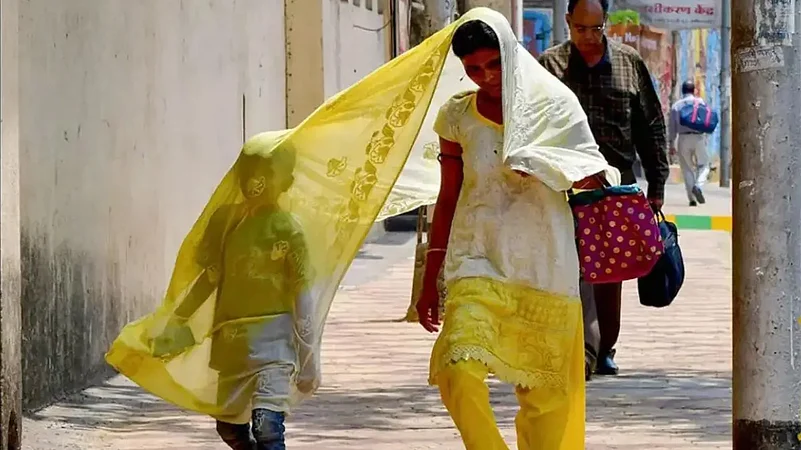There’s no denying that the world is getting dangerously hotter, even as the rains come down across India.
More than 1000 pilgrims, in Saudi Arabia for the hajj in Mecca last month, died as temperatures hit nearly 52 degrees Celsius (125 degrees Fahrenheit). The organisers of the Paris Olympics are worried about heat that could flatten athletes and visitors.
This year record heatwaves have scorched countries from the United States to Mexico and Thailand, with deaths mounting and financial losses growing as it becomes too hot for many people - from construction workers and market traders to delivery drivers - to work and earn effectively.
India is among the nations hardest hit by heat this year. Since mid-May, New Delhi has battled 38 consecutive days with temperatures above 40 degrees Celsius (104 Fahrenheit). Part of that heatwave overlapped with the country’s six-week election period, with millions of voters standing in line in sapping temperatures.
But India - long accustomed to dealing with intense heat - also has a long history of innovation in keeping people cooler and safer on blistering days.
Heat risks must be taken seriously at all levels of government. South Asia’s first Heat Action Plan was developed in the Indian city of Ahmedabad in 2013 as a way to focus city staff and resources on the heat threat. Credited with avoiding about 1,100 deaths each year, the plan - which includes measures such as training health workers in managing heat illness, putting in place cooling centers and setting up early warning systems - has now been replicated in dozens of other Indian cities.
A broader heat plan for the entire northern state of Uttar Pradesh - India’s most populous - is also being set up, with the help of Natural Resources Defense Council (NRDC), which focuses on climate action that prioritises health, equity, and economic resilience. NRDC has also worked with the Mahila Housing Trust, a women-led grassroots development group, to open the first net-zero cooling station in Jodphur in April.
India’s leaders are advancing creative solutions to make their cities more heat resilient. They have created heat wards in hospitals and special heat clinics, and painted roofs white or covered them with plantings to keep buildings cooler. More people are staying comfortable without air conditioning thanks to the planting of more trees and the revival of historic air-flow-promoting architectural techniques as temperatures rise.
To deal with the economic drag caused by hot days, innovative heat insurance schemes are also starting to play an important role. Many trial programmes have been developed to provide income support payouts when temperatures surpass a predetermined threshold to women who work in some of the most heat-exposed jobs, such as market vendors, head loaders, farmers, and salt pan workers. This enables them to feed their families even in the event that they are unable to work, pay for their children's school fees, or replenish spoilt market goods.
During this heat season, more than 50,000 members of the Self-Employed Women’s Association (SEWA) for the first time received such payouts, through insurance put in place with Climate Resilience for All, a global non-profit working to protect the health and livelihoods of women as extreme heat impacts grow.
However, India, like many other nations worldwide, is experiencing an increase in the health risks associated with extreme temperatures despite innovations to lessen the effects of heat. Losses in terms of money and productivity are also increasing as businesses of all sizes find it more difficult to run on these scorching days.
What could help, in India and beyond?
Ensuring enough finance is directed at the increasingly urgent problem is key to making sure people and businesses are prepared for hotter days to come, as the fossil fuel emissions that drive climate change continue to rise.
Cities and states with heat action plans need the money and technical resources to implement them, and such plans need to be expanded rapidly to cover communities facing worsening heat and designed to meet the needs of heat-vulnerable groups. This includes the very young and old, people dealing with chronic illness and women; especially those working in the heat, particularly when pregnant, who face the physical, cultural, and financial burdens of extreme heat.
As jobs are created in a construction boom across the country, legions of construction workers will need adequate protection from increasingly severe heat. The building boom also offers an opportunity to ensure new construction is fit for hotter times, using materials and architectural designs that can keep residents cooler while using less energy, and minimising the urban heat island effect that comes from glass, asphalt, and steel that hold and radiate heat.
Amid all the construction, making sure a network of shady outdoor green spaces is available also will help provide respite for those who must work and travel outdoors on very hot days.
Work is needed as well to figure out which heat risks different kinds of workers face, and begin putting in place protections, where possible, against those, from shifted work hours to mandatory breaks or better shading or other cooling systems for those most at risk on hot days.
Further, India's relatively new, global multilateral, the Coalition for Disaster Resilient Infrastructure, a platform with 39 country members, is an ideal vehicle to share knowledge and build countries' capacity for addressing extreme heat.
None of this is easy. But as India, the world’s most populous nation, experiments with innovation to protect its people and businesses from extreme heat, it could influence how many other countries around the world tackle an intensifying problem; one that is driving soaring damages to public health and economies across a huge swathe of the world.
India has led the world on many innovations, from low-cost vaccines to digital systems that now help deliver public services more effectively to its 1.4 billion people.
Can it now lead to innovative and lifesaving extreme heat action too?
(Dipa Singh Bagai, Country Head, NRDC India, and Kathy Baughman-McLeod, CEO, Climate Resilience for All)

















